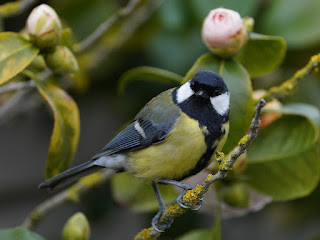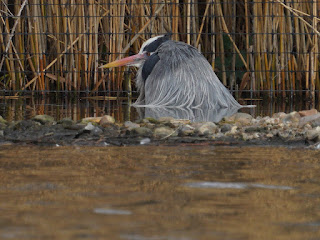One of the Song Thrush pair at the Henry Moore sculpture scuttled along under the bottom hedge, a place well separated from the busy path so that a bird can have a bit of peace and quiet.
There are still plenty of Redwings on the Parade Ground, but they will probably leave soon.
A male Wren beside the Long Water did a little dance to impress his mates. Wrens are polygamous and each mate has a separate nest.
The Long-Tailed Tits in the gorse bush have almost finished the main structure of their nest.
One of the pair near the bridge arrived with a bit of moss. We don't know how their nest is doing because it's hidden in the brambles.
A Coal Tit posed on top of a bush in front of the gold leaf of the Albert Memorial.
A Great Tit stared out from a camellia.
A Chaffinch looked down from a twig near the bridge.
A tricoloured Feral Pigeon wandered through a patch of crocuses.
The Rose-Ringed Parakeets now have some new leaves to camouflage them.
A Grey Heron nearly got out of its depth behind the gravel bank on the Long Water. They can swim, but not well and they don't like doing it.
A parent at the island climbed out of the nest to avoid being pecked by its hungry young.
A pair of Great Crested Grebes displayed on the Serpentine. One of them rushed off and assumed the 'cat' posture, then they reunited and went on displaying.
Another pair were building a messy nest against a wire basket at the Serpentine island. They lack the skill to attach a nest properly to wire mesh, so probably a Coot started this nest and they have stolen it.
The Egyptian Geese on the north side of the Serpentine are still hanging on to their last two goslings. No others survive anywhere on the lake.
A Canada Goose chased away a Greylag ...
... and returned triumphantly to his mate: 'Didn't I do well, dear?'
The Mallard drakes are looking their best now.















I don't think she is too enthused about his performance.
ReplyDeletePoor waterlogged Heron looks aggrieved. As in, "how did I end up in this position". And Grebes ought to give a thought to the notion of outsourcing nest-building to Coots, and then taking over.
A dancing Wren! I have never seen anything like that ever!
Canadas' triumph ceremony is usually more warmly received. She was unusually unenthusiastic.
ReplyDeleteThe Grey Heron was OK. It walked up the bank into shallower water and shook itself dry like a dog -- unfortunately just as I had put down the camera and was walking away.
There are currently three Coot nests occupied by Great Crested Grebes. It's a common occurrence, but more often than not the Coots win in the end.
Quite an unusual looking Feral Pigeon but very smart-perhaps some recent domestic origins?
ReplyDeleteWould loved to have watched the Wren doing his dance. Certainly hearing a lot of Wren singing now.
Even though they are so ubiquitous around London a very aesthetically pleasing shot of the Ring-necked Parakeet.
I'm completely ignorant about how the original Rock Doves lost their stable grey colours and diversified into all kinds of shades and patterns? Was it due to humans breeding from the odd mutation, or did it happen naturally? And why are the majority of London pigeons Blue Chequer? It must be a dominant gene that has appeared somehow.
DeleteI think selective breeding from mutations plays a part in some of those forms & some domestic forms do seem quite extreme in the same way as dogs & other domestic animals are. Many years ago I did review a scientific tome on Feral Pigeons for the LNHS but I'm afraid I don't remember much about the genetics, but there must be selective pressures that render the blue chequer form dominant.
ReplyDeleteThank you. Maybe the selective pressure is being less visible to predators against the background of a sooty city -- the Peppered Moth story again. The wild grey form would be better camouflaged against its native rocks.
Delete